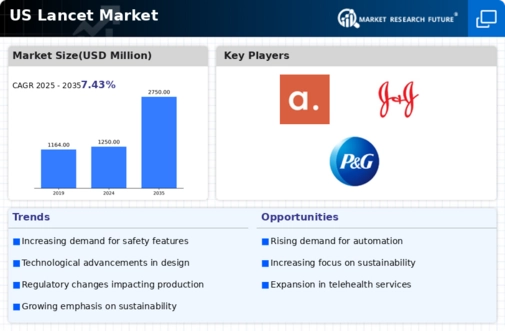Growing Awareness of Self-Monitoring
There is a notable increase in awareness regarding self-monitoring of health conditions, particularly among diabetic patients, which is a crucial driver for the lancet market. Educational initiatives and campaigns by healthcare organizations are promoting the importance of regular blood glucose monitoring. This heightened awareness is leading to an increase in the adoption of self-monitoring devices, including lancets. In the US, it is estimated that around 50% of individuals with diabetes are now actively engaged in self-monitoring practices. This trend is expected to continue, as patients seek greater control over their health. Consequently, the lancet market is likely to benefit from this shift, as more individuals recognize the necessity of using lancets for effective diabetes management.
Increase in Home Healthcare Services
The rise of home healthcare services in the US is a notable driver for the lancet market. As more patients prefer to manage their health conditions at home, the demand for home-use medical devices, including lancets, is increasing. This trend is particularly evident among individuals with chronic diseases who require regular monitoring. The convenience of home healthcare allows patients to perform blood tests without frequent visits to healthcare facilities. According to industry reports, the home healthcare market is projected to grow at a CAGR of 8.5% over the next five years. This growth is likely to positively impact the lancet market, as more patients seek accessible and user-friendly solutions for their healthcare needs.
Rising Prevalence of Chronic Diseases
The increasing incidence of chronic diseases in the US is a pivotal driver for the lancet market. Conditions such as diabetes, cardiovascular diseases, and obesity necessitate regular monitoring and management, leading to a heightened demand for lancets. According to recent health statistics, approximately 34.2 million Americans are living with diabetes, which translates to around 10.5% of the population. This growing patient base is likely to propel the lancet market, as these devices are essential for blood glucose monitoring. Furthermore, the aging population, which is more susceptible to chronic conditions, is expected to contribute to the market's expansion. As healthcare providers emphasize preventive care, the lancet market is poised for growth, driven by the need for effective disease management solutions.
Regulatory Support for Medical Devices
Regulatory support for medical devices in the US is a significant factor influencing the lancet market. The Food and Drug Administration (FDA) has streamlined the approval process for new medical devices, including lancets, which encourages innovation and market entry. This supportive regulatory environment fosters competition and drives manufacturers to develop advanced products that meet the evolving needs of healthcare providers and patients. Additionally, the FDA's focus on ensuring the safety and efficacy of medical devices enhances consumer confidence, which is vital for market growth. As new lancet products enter the market, the overall landscape of the lancet market is likely to become more dynamic, with a wider variety of options available to consumers.
Technological Innovations in Blood Sampling
Technological advancements in blood sampling techniques are significantly influencing the lancet market. Innovations such as micro-lancets and automated blood sampling devices enhance user experience and improve accuracy, making them more appealing to both healthcare professionals and patients. The introduction of smart lancets, which can connect to mobile applications for data tracking, is also gaining traction. These innovations not only streamline the blood collection process but also provide valuable data for diabetes management. The US market is witnessing a shift towards these advanced devices, which are expected to capture a larger share of the lancet market. As technology continues to evolve, the demand for more efficient and user-friendly lancets is likely to increase, further driving market growth.














Leave a Comment